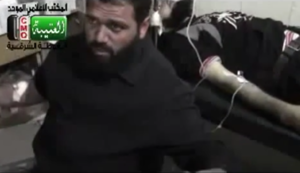Alleged Chemical Attack in Damascus, March 19, 2013

In the Damascus suburb of Otaybah (alt Uteibah, Ateibah, etc. - Arabic: العتيبة ) on the morning of March 19, 2013, at least 7 people, including a baby, were reportedly killed after rockets with a "foul-smelling" water-like substance landed there. (Mackey).
Samples said to be from Ateibah were later said to test positive for sarin, but it's unclear if that was by soil or blood samples, and so whether it was military grade (odorless) sarin, or terrorist-improvised (unpleasant-smelling) sarin.
The attack coincided, apparently to within minutes, with the attack in Khan al-Assal, Aleppo that targeted a Syrian Arab Army checkpoint in a Shia-majority village recently re-taken from rebels. Dozens of civilians and soldiers died on the spot, with soil and blood samples said (by Syrian and Russian sources) to test positive for sarin, the improvised kind, delivered by terrorists using locally made rockets.
It also was the same day as an apparent attempt in Homs, suggesting someone had planned three attacks to coincide this day in Syria's three main cities (no deaths were reported for Homs. The claim was never repeated, and it faded away quickly).
The Ateibah attack was reported but little noted at the time, but mattered behind the scenes; along with a December, 2012 attack in Homs, Western states instantly linked it with Khan al-Assal as one of three alleged chemical attacks that must all be investigated, now that Syria was demanding a UN investigation of the Aleppo attack. Besides intrusive demands and displays of bad faith, this three-incident demand initially may have "torpedoed" Syria's request. (see also ACLOS: UN Investigation)
Location
Ateibah is a small town in east Ghouta, 25km east of Damascus, here on Wikimapia, by lake Otaybah and near the airport. It's not far from the site of the infamous Ghouta chemical massacre five months later, and also near a majority of Syria's other reported chemical attacks.
Otaybah was apparently under rebel control at the time (March, 2013), but was back in gov control by mid-2014 at the latest, and since (see Peto Lucem maps, previous versions here.) Al-Hadath News (Arabic) reported on May 8, 2013, that the Syrian army had just regained control of Otaybah, as well as Abbadeh, Qaysa, al-Bilaliyah, and Deir Salman (all nearby), while clashes continued in Al-Nashabiyah and Harran Awamid, to the north and south of this area (map provided: red towns re-taken, yellow still seeing clashes. The only group mentioned as controlling at least some of these areas is Liwa al-Islam ( لواء الاسلام - later Jaish al-Islam), a "formation of infidels who are fighting under the banner of al-Qaeda."
Death Toll
By opposition records (VDC), at least seven people died from this incident: 6 civilian men were listed under the right date (spelling adjusted here):
- Qasem Abu Kheir
- Malek Abu Kheir (brothers: video shows them, about the same age, quite young, probably under 18, purple lips (cyanosis))
- Hasan Qashisheh (video, yellow mucous, possible eye damage)
- Husam Qashisheh
- Yousef Qashisheh
- Unidentified: video (Yellow mucous.)
There seems to be at least two kinds of death displayed: clean but cyanotic, and pouring yellow mucous. That could mean two or more different poisons were used.
The last appears like a rebel fighter, in a room with three survivors who look like rebel fighters. But as far as we know the other men were civilians. They came from two families, in both cases, with no wives or children. That's noteworthy pre-death segregation, consistent with these being captives of local terrorist forces.
The name Qashishe (Arabic: قشيشة ), repeated here three times, seems to be of Aramaic origin. That language is associated with the ancient Christian community in Syria, and still spoken to present day in places like Maaloula, northeast of Damascus. Qashishe seems to mean elder, a revered class in antiquity associated with the priesthood. So the adult males singled-out in the largest number for this Assad attack were from a likely Christian family.
- stray entry, documented late: Mohammad al-Sawah, child-male, from Harasta. Martyrdom location: Damascus Suburbs: Otaiba. Photo. visual notes: no clear symptoms. Are those chemically damaged eyes, baby eyes, ill baby eyes? Unsure. Notes: "Two weeks old, IDP with his parents, the parents didn't allow documenting his name until today so the exact date of death is unknown but he was exposed in 19/03/2013"
"IDP" means internally displaced: expelled, fled, or kidnapped from one area, winding up in another area, that was or becomes another rebel-controlled area. These often have bad luck there and die in alleged regime attacks of various kinds, especially chemical ones.
Samples Controversy
Forthcoming... (see Talk:British involvement in Syria)
Sources
- Local Coordinating Committees fierce shelling with chemical rockets targeted Ateibeh town today which resulted in martyrs and a large number of wounded, including suffocating and nausea cases and headache, vomiting and hysteria cases ... the martyrs are Husam Qashishe, Hasan Qashishe, and Yousef Qashishe.
- James Miller:
- Robert Mackey, NYT (presents 4 videos with content translated and quick visual notes)
- ...